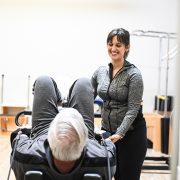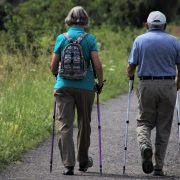5 Reasons Exercise is Hurting Your Back
The research continues to show that the best “treatment” for back pain is exercise.
But what do you do when exercising causes back pain instead of helping?
This is one of the most common frustrations I hear from our clients. The doctor looks at their back and takes an X-ray. He or she only sees something like arthritis or degenerative disc disease. Surgery doesn’t make sense – so the advice is to go exercise – and specifically to strengthen their core.
But when it doesn’t work they are at a loss.
Why would exercise hurt your back when the research overwhelmingly shows that it’s supposed to help?
Here are 5 reasons why exercise is causing your back pain…
1. It’s the wrong type of exercise
The research isn’t wrong about exercising and back pain. It doesn’t always reveal the specifics on the type of exercise that’s being done. For example, walking is considered one of the best activities for back pain sufferers. For the majority it will help significantly. But I also have clients who get worse just walking to their mailbox at the end of the driveway.
What the research is really saying is that movement – not necessarily “exercise” – is what’s really good for back pain – even acute back pain. But you need to make sure it’s the right type of movement for YOUR specific type of back pain. If you get the type of exercise or movement wrong – you’ll feel worse. It’s one reason why exercise will sometimes hurt your back instead of help.
2. Stability training is introduced too soon
Stability training is an important part of back pain recovery – but I often see it introduced too soon. Mobility is something you always want to look at first. If you don’t have full mobility in your spine, there is a reason. You want to make sure you explore that fully and get the spine moving the way it should be before you begin stabilizing or strengthening it.
Every now and then I stabilize first, but it’s rare. More often than not I see that people with long standing back pain are suffering from a mobility problem that was missed. When your spine doesn’t move well, you risk developing compensatory movement patterns that cause structures in and around your spine to get irritated. You want to figure that out first before jumping ahead to stability training of your core and spine.
3. Your aren’t activating your core
Knowing how to properly activate your core is different from having good core strength. You can have the strongest abs in the world – but if you don’t use them when they count – your 6-pack abs are useless. Knowing how to properly activate your core is essential when you exercise, but especially when you have back pain. If you don’t activate your core properly when you’re lifting weights, or performing complicated movements that require good coordination, you’re setting yourself up for injury.
The ability to activate your core properly is developed through motor control training. It’s where we teach your mind how to recognize and activate specific muscles, during specific activities, so that it eventually becomes habitual. Pilates (when done properly and with a well-trained instructor) can accomplish this quite well. If you’re constantly having back pain every time you exercise or try to strengthen your core, it could be that you lack the ability to activate it when it counts.
4. You aren’t breathing properly
Not breathing properly – or not breathing at all – can significantly impact the effectiveness of your exercise routine and impede your ability to perform an exercise properly. As mentioned previously, knowing how to activate your core is crucial when you exercise, and in order to activate your core properly, you must be able to breathe properly.
Your deep core is made up of four parts: your deep abdominals, your deep back muscles, your pelvic floor, and your diaphragm. Your diaphragm is what controls your breathing. Let’s say you hold your breath when you exercise. When this happens it means your diaphragm isn’t expanding or contracting in the way it needs to for your deep core to be fully functional. Additionally, when your diaphragm doesn’t work like it should, it adds unnecessary strain and work to your back muscles. This is one reason why you might not be able to activate your core properly – and why exercise might be hurting your back.
5. You’re using improper form
The last and most common reason why exercising might be hurting your back is because you aren’t doing it right. There’s a lot of people out there who think posture and form don’t really matter. But they do.
If you’re lifting weights – especially when frequently and repetitively – you want your spine to be in good alignment. It might not hurt the first time you lift with improper for. But it will hurt when you get to your 100th rep. Same goes for body weight exercises. Just because you aren’t adding load to your spine doesn’t mean you can’t aggravate it by doing something with poor form over and over. That’s really where people get in trouble. If you’re going to exercise – and you want to exercise daily – do it with proper form and posture or it’s going to catch up to you and cause you unnecessary back pain.
If exercising is currently hurting your back…
Consider speaking to one of my specialists – they’ll ask you all about what’s been going on – and see if we would be a good fit to help you!
If you’re local toPortsmouth, NH – Click here to book a free discovery visit.











